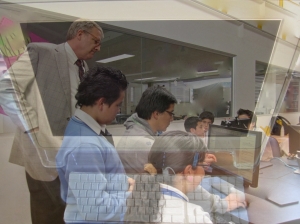In Lewis Carroll’s Through The Looking Glass, Alice leaps into a topsy-turvy, alternate world. A giant chessboard with fields for squares and chess pieces as characters, across which Alice, herself a pawn, must journey to become a Queen and wake up at home again. Along Alice’s journey, the experiences she has and characters—including Humpty Dumpty, March Hare, and Hatter—she meets blow her mind. Teachers who step through the looking glass of technology find a wonderland of education, as mind-blowing as the world Alice encounters.
Thanks to computers, software, and the Internet, educational priorities, values, and roles are upside down and inside out. Cookie-cutter classrooms are no more.
Classrooms that were once places are now processes. Workstations and computer labs are gone, portable devices with wireless access have taken their place. Instead of the once standard school-day-week-year with corresponding courses, bells, and periods there is anywhere anytime learning.
In these classrooms, teachers jettison one-size-fits-all stand-and-deliver instruction that they once relied on. Replacing it with personalized and authentic learning approaches. They give and receive timely feedback—frequently. They use data from the feedback to refine, differentiate, compensate, and enrich their teaching. No longer recitation taskmasters here they are guides for students and partners in learning. Groupthink is unthinkable, collaboration the norm.
On this side of the looking glass every student from Ottawa, Ontario to Ankeny, Iowa and Yuma, Arizona is one click away from most every resource necessary for learning most everything. Roles and functions blur so students and teacher are learners. Technologically enabled and instructionally empowered, students morph from capitulators of facts into synthesizers of information and creators of knowledge. They use easy-to-use software to show their mastery of concepts, topics, and skills. The artifacts of their learning—images, videos, recordings, documents, and more—reside in digital portfolios that document their mastery and progress. Not surprisingly, here all students learn at high levels all the time.
Parents? On this side of the glass parents are active participants in their children’s learning and instruction. Through their child’s portfolio, parents monitor their child’s progress and communicate with teachers and other parents. They use it to provide and receive regular feedback, early warnings should things go awry, and accelerate should opportunities afford.
After stepping through, Alice struggles. She is an innocent child in a nonsensical adult world. She finds thinking and reasoning to be quite different here. To survive, Alice must adapt —play by new rules, learn a new language, and engage with a new, seemingly senseless, and oftentimes unpredictable order.
Much like Alice, teachers who step, fall, or are pushed through struggle to understand their new and apparently nonsensical world. Calm, quiet, and peaceful yet rapidly spinning to and fro from the changes wrought by technology, it is a seemingly absurd and surprisingly logical place.
What to do? Where to begin? Let’s ask Alice.
The way forward, as Alice discovers, involves awareness and adaptation. Finding herself in new surroundings, Alice adjusts to it in the “head”. She begins by rethinking her identity. Because, as she says, “I knew who I was this morning, but I’ve changed a few times since then.” The same happens to a teacher who identifies as a teacher but once through the looking glass must adjust to being a student and partner too.
As Alice shows, rethinking leads to growth and maturation. But, as she also shows, rethinking can be confusing and uncomfortable. Being ten feet tall was not comfortable, Jabberwocky with its bright colors and gibberish words calming. Problems familiar and solvable on one-side of the glass are, on the other side, puzzling and logic defying. That is why Alice, upon stepping through, feels directionless and tremendously alone. She has no support system, does not speak the language, and is unfamiliar with the terrain.
A teacher stepping into the high-tech world of education feels the same. If you are a teacher who has stepped through you know this to be true. You also know that, as does Alice, lacking direction and being lonely are temporary conditions.
Curiosity pulls Alice through the looking glass. Curiosity moves her forward and brings her back out. With a questioning and open mind, Alice greets various characters. Learning a lesson from each that enables her to move across the chessboard, Alice becomes a Queen, and wakes up at home.
Those of us who have met the characters, learned the lessons, successfully navigated the high-tech wonderland of education do not need to go back through the looking glass, as Alice did, to stay. Rather we must go back and come through again and again, each time bringing with us a teacher or two. By showing them the way through and sharing lessons about what to do once there, we enable the teaching profession and the field of education to grow and mature. This is the wonderland of learning each of us seeks.
Mark
Note: This is the seventh post in the Learning Lessons series. Please click the follow button on the right side of the blog page to be notified of future posts.


You must be logged in to post a comment.